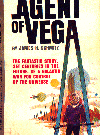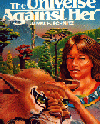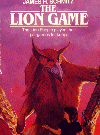James H. Schmitz
James H. Schmitz (October 15, 1911 – April 18, 1981) was the author of a number of science-fiction fantasy novels and stories. After his death, his out-of-print works retained an enthusiastic following and were republished in the 1980's. They are remarkable for their bold female characters (surprising even by today's standards), and also for the author's deft handling of psionics. Many of Schmitz' writings fall into one of two universes and have many interlocking characters. He wrote one set of tales set in the universe of the "Agent of Vega" series. He created a different universe in the "Federation of the Hub" series which includes over two dozen stories and novels. His writings exist as eight novels and fifty-odd stories in several collections, most of which were published between 1960 and 1974.
During the late 1970's and early 1980's, a lively trade existed for out-of-print Schmitz books. Then in the 1980's, most of the Schmitz works were reprinted by Baen books. The Baen book reprints also became out-of-print, and in recent years, even public libraries no longer carry them as a result of the move towards electronic books rather than physical books. Most of the works have now been scanned into electronic form and are available through Amazon and other outlets, while the used physical books become rarer and more expensive. Schmitz' best work appears to remain quite popular and well known despite these difficulties.
List of works
This is not a complete list, but rather contains some of the more important works.
Agent of Vega (1960)
Agent of Vega is a book consisting of four long stories that were originally published 1949-51 in Astounding Science Fiction Magazine. At least three editions of the book were published.
The four stories in the book are Agent of Vega, The Illusionists, The Truth about Cushgar, and The Second Night of Summer.
The first three stories center around Iliff, a seasoned Zone Agent who is an expert trouble-shooter in the employ of the powerful but over-extended Psychology Service. His assignments are doled out by the Third Coordinator, a highly competent boss whom Iliff loves to despise. The Third Coordinator sends Pagadan, a representative of a new species, to apprentice with Iliff. And when she arrives, Iliff finds himself trailing after his old nemesis, U-1. Iliff is extremely well-balanced mentally about everything except U-1, who once defeated him and left him for dead. The Third Coordinator has evaluated, and uses, Iliff's sensitivity about this humiliation. Iliff knows how he is being manipulated and hates it, but he hates U-1 enough to endure it.
Zone Agent Iliff's disgruntled cynicism, and the razor-sharp dialogue between him and his boss, the Third Coordinator, make this a very fun read. The situations which the Zone Agents investigate are also quite intriguing. These are "good" psi cops chasing "very bad" runaway psi's who are menacing those around them and could only be stopped by other psi's. The bad gize have to get very bad indeed before the Psychology Service gets motivated to send someone after them. As usual, Schmitz' plots become very creative yet stay within rational boundaries.
The first three stories are considered very good, and the last one a little less so. The last one deals with a different Zone Agent who is not quite as captivating as Iliff.
A Tale of 2 Clocks (1962)
A Tale of 2 Clocks is a Trigger Argee adventure, and touches on Quillan, Pilch, plasmoids, and Old Galactics. Trigger is one of two recurring female lead characters for Schmitz. Like Telzey, she is privileged and extremely capable, but unlike Telzey, she has little or no psionic ability. Instead, she is equipped with above average intelligence, training, and a dollop of creativity.
Several of Schmitz' strengths as a writer come out in this yarn. Human perception gets questioned, as the alleged culprits turn out to have a very unexpected nature and motivation. Qualities of "good" and "bad" are played with ironically. Pilch is one example: powerful and unrelenting enough to take on a forbidding mien to Trigger and others, but Schmitz makes clear that she is basically benign. She also appears in other works, as does the resourceful free-lance, semi-criminal detective, Quillan.
This story does not move as quickly as some other works, but is nevertheless a thought-provoking and satisfying read.
The Other Likeness (Analog, July 1962)
The Universe Against Her (1964)
The Universe Against Her was first published in 1964. It consists of two very long stories which can be regarded as the first two Telzey Amberdon adventures. If you're new to Schmitz, this would be a good place to start, and it is the seed for several subsequent Schmitz stories using the same lead character, and which occur in a region of space identified as the Federation of the Hub.
The first of the two stories describes how a very young Telzey first learns about her psionic ability, which then allows her to overcome several obstacles and avert an impending disaster. The second story involves Telzey working to gain greater control over her new-found talent and struggling to avoid becoming a tool of the powerful Psychology Service. It will not be her last encounter with the secretive agency, and while she never allows herself to fall under its control, subsequent stories show that she is sometimes willing to work together with the agency when dealing with a sinister power needing to be taken down.
It is probably reasonable to speculate that Schmitz' Psychology Service (appearing in many stories about the Telzey universe) served as a model for a similar agency, many years later, in the Babylon 5 television series written by J. Michael Straczynski. Babylon 5 ran 1993 - 1998, and although its author has not acknowledged any influence from James Schmitz, the similarities in the two agencies are unmistakeable. The Babylon 5 agency's intentions and goals are less transparent, but they are similarly powerful, largely invisible, and characters with and without psionic capabilities fear falling under the agency's iron control.
The Witches of Karres (1966)
The Witches of Karres was nominated for a Hugo in 1967 (it lost to Heinlein's The Moon Is a Harsh Mistress). It sold very well and is still very popular. It does not take place in either of Schmitz's usual universes. Though not the favorite of die-hard Schmitz aficionados, it is a fun read. It may have been Schmitz' most popular book ever.
In recent years, three sequels were written by other authors besides Schmitz; the 4-book set of books about the witches sells on Amazon for more than $30 as a Kindle book in 2020.
The Custodians (Analog, Dec. 1968)
The Demon Breed (1968)
The Demon Breed was first published as a two-part story, entitled The Tuvela, in Analog in September and October of 1968. It appeared as a novel in book form (ACE 1968 edition).
Unlike other of Schmitz' young female heroines, the heroine of The Demon Breed has no particular psionic ability. The author does equip her, however, with a number of other attributes and tools for the struggle against mysterious demon-like creatures whom she encounters. Like the other Schmitz heroines (Telzey and Trigger), she is able to formulate and carry out complex tactical plans quickly. She is also supremely familiar with her home planet's environment, which the so-called demons are not.
This novel requires more effort than some of Schmitz' work. It requires the reader to gain a detailed understanding of the environment being portrayed. For those who can deal with its the complexity, the story is a great adventure. Unlike most other Schmitz stories, it takes place in a wild habitat and without much aid from technology. Aside from the heroine's unpredictability, adaptability, endurance, and native knowledge, the plot relies on her familiarity with a friend whom she knows is involved, but with whom she cannot directly communicate.
Resident Witch (Analog, May 1970) - a Telsey Amberdon adventure
Compulsion (Analog, June 1970)
The Telzey Toy (Analog, Jan. 1971)
Company Planet (Analog, May 1971)
Glory Day (Analog, June 1971) - Telsey and Trigger
Poltergeist (Analog, July 1971)
The Lion Game (2-part, Analog, Aug. and Sept.1971)
The Lion Game was first published as a two-part story in ANALOG Magazine in August and September of 1971. The book consists of those two very long stories about Telzey Amberdon. The stories seem to follow directly after The Universe Against Her. The first story is a mystery with horror and science fiction thrown in. Telzey sneaks off from her friends during a camping trip to investigate a distress cry that she sensed. The story is all about what happens to her as a result.
The second story is about the aftermath to the first story, though it takes place somewhat later. Telzey finds herself hunted by the villains she foiled in the earlier story, and she ends up traveling to another planet to confront them at the source. Some people find the second one more complex and hard to follow.




